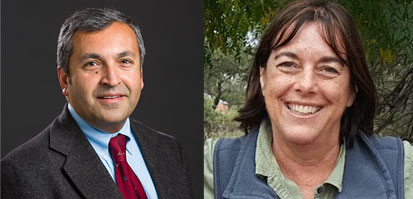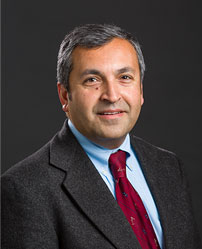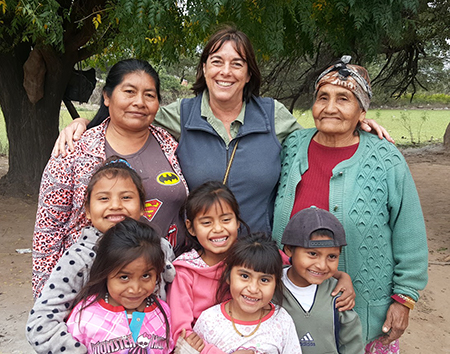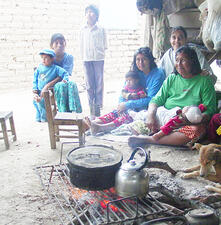
At the Intersection
For the Poorvu Center’s first faculty newsletter of 2021-2022, we feature three courses taught by four exemplary instructors. These courses successfully use collaborative learning as a strategy for advancing student learning. Teams and groups have received critical attention in recent decades from researchers across many disciplines, and these practices have been well-established as an important method for student engagement.
However, consideration of using student groups inevitably raises practical questions. How can we manage group dynamics, hold students accountable, and use teamwork to improve our pedagogy? What is the difference between using groups in-class and out-of-class? Are formal or informal groups better? We hope you’ll find your colleagues’ discussions of these questions (and more) illuminating and thought-provoking.
Sincerely,
Jenny & Lucas
Jump to:
Using Small Groups in Class: Professor Mayur Desai
Conversations Around the Fire: Dr. Claudia Valeggia’s Approach to In-class Group Work
Operations Engine: Gamified Problem-Solving with Professors Alizamir and Meng
Professor Mayur Desai
Using Small Groups in Class
 Breaking large classes into small groups has been used as an educational tool for centuries, but recently the practice has garnered increased attention in higher education. Studies have focused on the demonstrable benefits of cooperative learning, on its usefulness for problem-solving in science courses, and practical methods to implement it in classes. Here at Yale University, Professor Mayur Desai uses small groups in his graduate-level Master of Public Health classes and has a lot to say about their effectiveness.
Breaking large classes into small groups has been used as an educational tool for centuries, but recently the practice has garnered increased attention in higher education. Studies have focused on the demonstrable benefits of cooperative learning, on its usefulness for problem-solving in science courses, and practical methods to implement it in classes. Here at Yale University, Professor Mayur Desai uses small groups in his graduate-level Master of Public Health classes and has a lot to say about their effectiveness.
As an Associate Professor of Epidemiology in the Yale School of Public Health, Desai directs the one-year Advanced Professional MPH Program and teaches courses on epidemiologic research methods and data analysis. He coordinates the “Clinical and Health Services Research Methods” course for Yale’s National Clinician Scholars Program and teaches the quantitative methods portion of the curriculum.
He began using small groups more often in recent years, appreciating their effectiveness in getting students to actively participate, emphasize skills over content, and build a sense of community in class. “When I use small groups in class, or in breakout rooms on Zoom,” says Desai, “I get responses to the open-ended questions that I normally might not.”
One of the collaborative learning strategies that Professor Desai likes to use is the “think-pair-share” method, which requires students to individually think about a topic or answer a question, and then pair up with another student to share their ideas or answer. This allows every student an opportunity to engage with the material and learn from their peers.
Another strategy that Desai has found effective is putting students into small groups (usually 4-5 students) and having them answer a series of focused questions: for example, questions to sharpen their critique of a published epidemiologic study. “To avoid having some members of a group dominate the discussion, I tell the groups to start by quietly thinking about the answers and then begin their discussion, allowing each member of the group to take the lead on a different question,” he explains. “This allows students who may need a little more time to formulate their answers or may be reticent to fully participate an opportunity to do so, contributing to a more inclusive learning environment.” When the class comes back together, a different group takes the lead to kick off the discussion for a particular question. As with the “think-pair-share” method, the goal is to have students be active learners who are engaging with the material and with one another.
Some faculty worry about how to fairly grade these kinds of small groups. However, Desai has not found this to be a problem. “I never grade participation,” he says. “I give students many opportunities to participate and don’t feel like it is necessary.” He also designates a random spokesperson from each group to help avoid the challenge posed by a few extroverted over-contributors.
Another challenge to using small-group work is that it can leave less time for other learning. Reorganizing lecture content via pre-recorded videos is one way to deal with the problem, allowing students to dig into more challenging content together. “Class feels less lecture-driven and students like it,” he says of this method. “They can watch my lectures at their own pace, on their own time, and come to class already familiar with the content.”
Desai’s experience shows that there are many benefits to group work, including making the most of in-person time and emphasizing application of skills. “It is a great way to get to know your students, and help your students know each other,” he says in conclusion. That alone may be worth the effort.
Dr. Claudia Valeggia
Conversations Around the Fire
 Professor Claudia Valeggia specializes in Biological Anthropology. In her research, she explores interactions between human reproductive biology and the cultural and ecological contexts in which it develops. Originally from Argentina, she received her PhD from the University of California, Davis, and has been teaching at Yale since 2014.
Professor Claudia Valeggia specializes in Biological Anthropology. In her research, she explores interactions between human reproductive biology and the cultural and ecological contexts in which it develops. Originally from Argentina, she received her PhD from the University of California, Davis, and has been teaching at Yale since 2014.
Q: Tell me about using small group work. Do you use it in all your classes?
I use it in all my classes, from 25 students to 150 students. It’s an excellent tool and goes with my own pedagogical approach by putting the learning experience into the hands of students. I invite them to own their learning and through these exercises they can have more agency.
Q: Did you always use group work in this way?
Always. The material I teach is very dense, and it gives the students an opportunity to break it down into chunks. It also is a way to find creative ways to incorporate the material. There are many different ways to use it.
Q: You call this “community learning.” Why do you like that term?
Community learning is about learning from each other. I have been learning from my students for thirty years and keep learning about how to best use the approach. It is a mix of Paulo Freire [Brazilian educator and philosopher] and indigenous pedagogical approaches. I try to emulate the discussions around the fire in indigenous cultures. Sometimes I wish I could have a fire in class!
Q: Tell me about how this approach lowers the stakes for the students.
The students feel like they can speak their mind without the pressure of being right. I do it so frequently that they relax and talk freely. I don’t even walk around, because I noticed that when I approach, their body posture changes and tightens up. This is their time. They also know that there is no grading of these activities.
Q: You’ve said before how this approach strips down the hierarchy and increases engagement.
Absolutely. It works for introverted people like me, who drain their energy when speaking in public. They have to talk but are not as exposed. It’s another bonus of small group conversations.
Q: What ways does it make our jobs different?
It’s your opportunity to listen to them. It’s a little window into their minds that we seldom get, and it’s spontaneous. These small groups reveal things that are not obvious about the way I explain things or about what topics move them more than others.
 Q: How do you keep everyone involved?
Q: How do you keep everyone involved?
At the beginning of class I remind them that this is an opportunity for participation, and I have 5% of the final grade. But I tell them that verbal participation is just one aspect. They keep journals, with things to remind them of class discussions, things they wonder about the subject. I can see the least participatory students with rich thoughts in their journals.
Q: Are they formal or informal groups?
Totally informal and I regularly mix them up, so they are not always the same.
Q: And what kinds of feedback do you give?
It is a very dynamic practice. Sometimes it happens organically. Let’s stop, I’ll say, and discuss it in small groups. I have it lucky because the things I teach are particularly engaging for their lives. I teach about sex, I teach about bodies, I teach about reproductive health.
Q: Do you use any technology?
No technology. Students rotate leading the discussions. In one small class, the students used Kahoot and a version of the Taboo board game.
Q: You have already touched on this, but how does your field of Anthropology inform the practice?
It’s the way we do it in the field. It is the way young people learn, the way knowledge is transmitted from older generations to younger generations, but it is also co-created in a way. So, when I participate in chats about my own research in northern Argentina, we sit around the fire, we pass the maté drinks, and everyone has the opportunity to say something, and the result is very rich. It sounds a little idyllic, but you can incorporate elements of it. Work in small groups gives you a taste of how learning may happen in a more relaxed setting.
Q: Anything else you’d like to say to other faculty about this process?
Many times as professors we feel, how can we do all this when we have so much material to cover? Don’t be afraid to cut down on content. Make it part of your teaching. Provide these opportunities to engage with the material in a different way.
Operations Engine: Gamified Problem-Solving with Professors Alizamir and Meng
Operations Engine: Gamified Problem-Solving
 Dr. Saed Alizamir and Dr. Lesley Meng’s MGT 422: Operations Engine class has a lot to teach us about small group work’s potential when merged with gamified problem-solving.
Dr. Saed Alizamir and Dr. Lesley Meng’s MGT 422: Operations Engine class has a lot to teach us about small group work’s potential when merged with gamified problem-solving.
Every year, these two professors teach 360 students across five sections of this core class, in which all Yale M.B.A. students must enroll. The class teaches how to manage a factory or service industry business, focusing on improved process and design. Students learn scientific principles and quantitative skills in order to better measure and evaluate the way processes work, or don’t, and to improve business-world functionality.
For one week during the second half of the course, Meng and Alizamir run an out-of-class competition between roughly 120 groups of three students each. This is a chance for the students to take the quantitative tools already learned and apply them to a real-world problem. “Some of what we teach them as M.B.A. students is textbook,” says Meng. “Little self-contained problems that are hard to apply directly. So, we want to make sure they have an opportunity to expand their learning beyond the classroom.”
Alizamir agrees. “It’s not just using a formula,” he says. “It exposes them to a real-world problem.”
Called the “Littlefield Simulation” by its creators and used by many universities, this gamified competition requires students to plan a strategy for running a factory, and then put it into practice. Each group has three days before the simulation opens to understand the setting of the game before the competition begins. During the game, they have the chance to make decisions, buy and sell machines, borrow money, optimize ordering policy, manage wait time for the customers, and more. They try to improve their bottom line, compete against the other groups, and whoever achieves the best outcome for their factory, wins.
The game integrates concepts taught in the course, like process design, inventory management, and waiting-time management. Students must apply and integrate these concepts together in a unified practical exercise. And though it could technically be run as a competition between individuals, it works better as a group project for a wide variety of reasons. “We want students to brainstorm and discuss. They learn from each other and all of them have something to say,” says Alizamir. “It creates a sense of teamwork and a sense of pride.”
The professors start the course by giving the students in-class group work to prepare them. But the Littlefield Simulation is on a completely different level, operating for seven full days and nights in the background of the class. In that way it simulates a real business, which doesn’t stop just because a factory whistle blows. The large, multifaceted project plays to the strengths of members of the group and keeps everyone involved. “There is a heterogeneity across students in how much they choose to engage with it,” says Meng. “However, in aggregate they are accountable for bringing something to the group.”
“It’s too complex for just one student to do,” agrees Alizamir. “In the real world of business you have to be able to manage this sort of teamwork.”
The exercise also breaks the large, mandatory classes down into manageable segments and puts the students in the drivers’ seat of their educational environment. “It helps shift the emphasis away from unidirectional teaching,” says Meng. “Students learn and think on their own.” There are other advantages, too. “In adapting the class to the pandemic, the simulation was an element that transitioned particularly well,” she continues. “We had some other in-person simulations that had to be shifted quite a lot, but this group activity was basically unchanged.”
Students have many incentives to do well on the project – other than 10% of their final grade. Professors Meng and Alizamir ask the students to submit an action plan at the beginning and a summary at the end that includes what worked (or didn’t) and what lessons they learned. During the “sometimes intense” simulation week, students can see their ranking, which provides a lot of incentive to those students who want bragging rights. And for those not moved by the drama of the game, there are other, more tangible rewards.
“Before COVID we gave t-shirts that read ‘Littlefield Champions’ to the winners, which they could wear around the School of Management with pride,” laughs Alizamir. “It’s fun. They bond with each other, even across sections, and with the faculty.”
Small group work is a valuable part of any class. However, gamifying this work by giving a pseudo-real-world problem that students must solve together has incredible potential for the way we think about education. “Our students come from a wide variety of backgrounds, all with unique skills,” says Meng. “This gives them a chance to learn from each other. They are interdependent and have to be engaged at every step.” Further Reading An important source for this topic is the Journal on Excellence in College Teaching, Volume 25, Numbers 3 and 4 (2014). The editors dedicated this special focus issue entirely to “Small-Group Learning in Higher Education—Cooperative, Collaborative, Problem-Based, and Team-Based Learning.” These fifteen articles provide ample research on small-group learning, collaborative learning, cooperative learning, and more, both inside and outside the classroom. They range from studies on how cooperative structures promote deep learning to practical task design for team-based learning. For those who prefer a more audio-visual experience, try this video by Dr. David Matthes of the University of Minnesota. “The Transformation of Teaching and Learning in Active Learning Classrooms” is a faculty-focused training video demonstrating how to integrate group-based active learning strategies successfully into the classroom. Poorvu Center consultants are ready to meet with you to discuss how best to incorporate group work into your courses. Request a consultation through our website.
Further Reading
An important source for this topic is the Journal on Excellence in College Teaching, Volume 25, Numbers 3 and 4 (2014). The editors dedicated this special focus issue entirely to “Small-Group Learning in Higher Education—Cooperative, Collaborative, Problem-Based, and Team-Based Learning.” These fifteen articles provide ample research on small-group learning, collaborative learning, cooperative learning, and more, both inside and outside the classroom. They range from studies on how cooperative structures promote deep learning to practical task design for team-based learning.
For those who prefer a more audio-visual experience, try this video by Dr. David Matthes of the University of Minnesota. “The Transformation of Teaching and Learning in Active Learning Classrooms” is a faculty-focused training video demonstrating how to integrate group-based active learning strategies successfully into the classroom.
Poorvu Center consultants are ready to meet with you to discuss how best to incorporate group work into your courses. Request a consultation through our website.
Subscribe
Subscribe to the Poorvu Center Faculty Newsletter by visiting Yale’s subscription center:
- Go to http://subscribe.yale.edu/
- Log on using your Yale NetID or a non-Yale email address
- Go to the “Departments, Centers, and Programs” section
- Locate “Poorvu Center: Faculty Teaching Newsletter”
- Click “Subscribe”
- Scroll down and click “SAVE”
